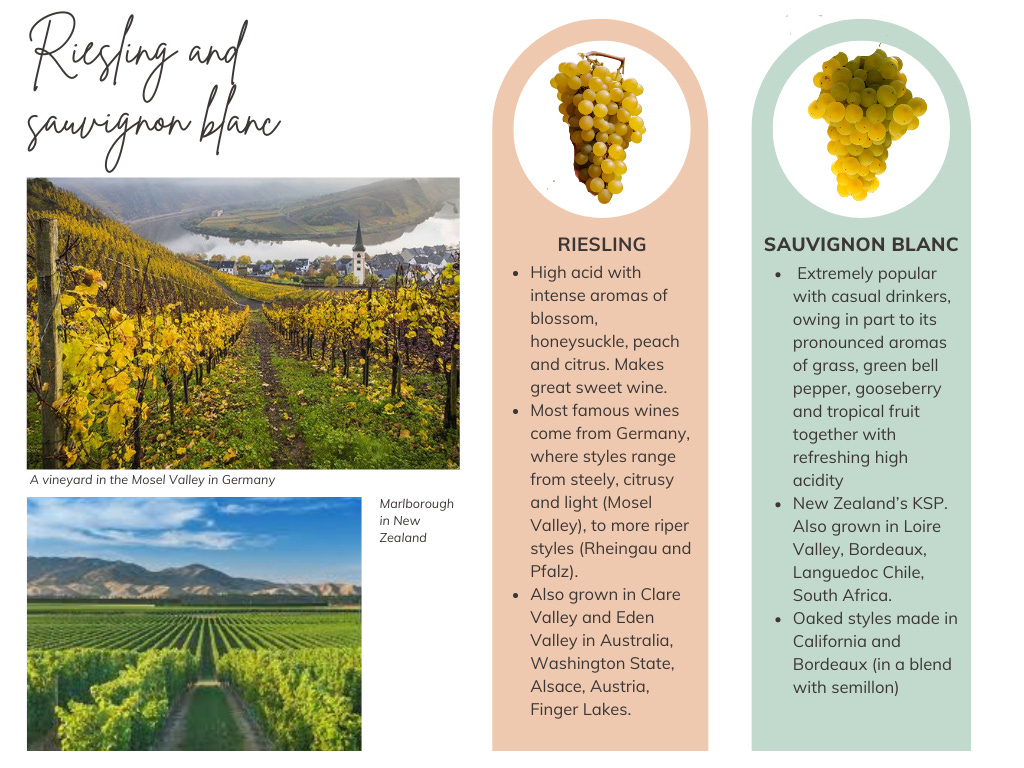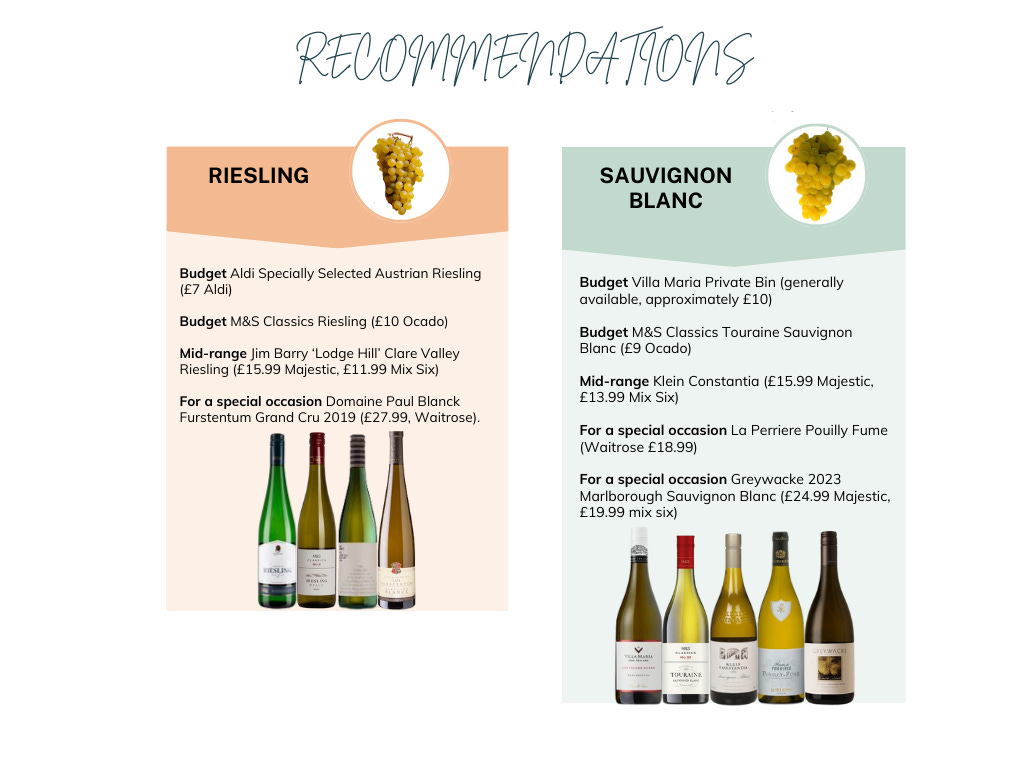Know Your Grapes Part 6: Riesling and sauvignon blanc
A hugely popular variety and an underrated one
By the time you read this I will be somewhere between Strasbourg and Colmar, hopefully sampling some excellent Alsace wine (more about that in a later post), but I’m not taking my laptop on holiday with me. There is a Substack function which enables one to schedule a post to be published at a later date, so provided I can decipher how it works, that is what I’ll be doing.
Unlike chardonnay and pinot grigio, which was covered in part five, riesling and sauvignon blanc are regarded as aromatic varieties. When you smell the wine you will experience pronounced aromas and the taste can be distinct. It’s no wonder both varieties have large fan clubs. As in the previous Know Your Grapes instalments, all the recommendations can be purchased in supermarkets or Majestic.
Riesling
Characteristics Known for its floral features on the nose (such as blossom), with honeysuckle and fruit ranging from citrus to tropical. You can smell petrol (yes, petrol) after the wine has aged for a while. Can age beautifully and its ultra-high acidity and steely nature means it’s well-suited to making sweet wines (the acidity giving linearity and preventing the wine from becoming too cloying) which rank among the best in the world, the flavour sometimes intensified by the actions of the fungus botrytis cinerea (‘noble rot’) while the grapes are on the vine.
The variety can also display oily, more textural characteristics in some regions (such as Alsace). Lots of riesling is made in off-dry and medium-dry styles with low alcohol. The variety can tolerate harsh winters, making the production of icewine (or eiswein, as it is known in Germany) possible.
Where is it grown? Most famously in Germany, where it can produce wines of incredible delicacy and intensity. Alsace in France, Clare Valley and Eden Valley in Australia, New Zealand, Finger Lakes, Lake Ontario and Washington State in North America as well as Austria. Plenty of other countries also grow it.
Coolness rating 3/5 Ask 20 Masters of Wine what their favourite white variety is and more than half will say riesling. Top-quality German riesling used to be more expensive than first growth Bordeaux at the turn of the 20th century. However, it has never really caught on with casual drinkers. The labels on bottles of German riesling can be confusing (although perfectly logical once you devote time to studying the country’s ‘pradikatswein’ and ‘qualitatswein’ categories, but most people would wisely devote their time to more pleasurable activities). The stigma of sweet liebfraumilch such as Blue Nun, which saturated the export markets in the 1970s and 80s, also means some Boomers are wary of drinking German white wine.
Recommendations
Budget Aldi’s Specially Selected Austrian Riesling (£7) has good typicity of a dry style, but it seems to be currently out of stock. The supermarket also does a Clare Valley riesling in a similar style. The M&S Classics Riesling (£10 Ocado) is an example of an off-dry style with peachy characteristics from the Pfalz region in Germany.
Mid-range Australian riesling is worth checking out, and Jim Barry’s ‘Lodge Hill’ from Clare Valley (£15.99 Majestic, £11.99 Mix Six) is made in a citrusy style and is a good example of the steely nature of quality riesling.
For a special occasion There is so much to choose from and many different styles and sweetness levels. Alsace riesling can be more textural and oily compared to German examples (although this is a huge generalisation), and if you think you’ll like this style then go for Domaine Paul Blanck Riesling 2019 from the Furstentum Grand Cru (£27.99, Waitrose). For top-quality German riesling your best bet is to consult an independent wine merchant, who can talk you through the different styles (The Winery, which has shops in Maida Vale and Fulham, specialises in German wine). For something different I would recommend a top-quality Spatlese German riesling, which has some sweetness and low alcohol, and have it with a dish with some heat, such as a Thai curry.
Sauvignon Blanc
Characteristics Together with cabernet franc is the parent of cabernet sauvignon, and like that variety can exhibit pronounced herbaceous aromas, as well as grass, asparagus, gooseberry and grapefruit. Tropical and stone fruit characteristics are also present in New World examples. Has high acidity and not too much body, which makes for a refreshing tipple. Unlike riesling, sometimes undergoes oak maturation, particularly in California and Bordeaux. Contributes to the blend in Sauternes, one of the most expensive sweet wines in the world.
Where is it grown? In the Loire Valley in France (most famously in the AOC of Sancerre), Bordeaux, the Languedoc, Australia, California, South Africa, Chile and of course New Zealand (mostly in the South Island), where it has been a phenomenon on the export market. Oaked styles common in California (where it is sometimes called ‘fume blanc’).
Coolness rating 5/5 Extremely popular with casual drinkers, particularly sauvignon blanc from New Zealand, which tends to have excellent aromatic intensity. Purists usually prefer Loire Valley styles, where the aromatics are more restrained but the wine can be excellent with a ‘wet stone’ characteristic. Oaked styles from Bordeaux (usually in a blend with semillon) can be great for those who prefer more texture. Something for everybody.
Recommendations
Budget The Villa Maria Private Bin is ubiquitous in the likes of Tesco, Sainsbury’s and Morrisons and is a good example of a typical New Zealand sauvignon blanc from the Marlborough region, with tropical fruit and grassy notes. It costs around a tenner. A more reserved style, reminiscent of the Old World, can be found in the M&S Classics Touraine Sauvignon Blanc (£9, Ocado). Touraine is a region in the Loire Valley and the sauvignon blanc is toned down a couple of dials compared to some New Zealand examples, with citrus and green fruit in place of tropical.
Mid-range It’s not only France and New Zealand which produces decent sauvignon blanc. Chile and South Africa are other countries to consider, and Klein Constantia’s sauvignon blanc (£15.99 Majestic, £13.99 mix six) from the latter country falls somewhere between the Loire Valley and Marlborough in terms of style, with stone fruit and citrus and freshness owing to the grapes being grown in the foothills of the Constantiaberg mountain close to the southern Atlantic.
For a special occasion If you want flintiness with green and citrus fruit and grassy herbaceousness then the Loire is the place to look. Sancerre is the most famous appellation there but Pouilly Fume can rival it for quality and the bottles can be cheaper. The La Perriere Pouilly Fume from Waitrose (£18.99) should hit the spot.
One of the most famous good-quality sauvignon blancs from New Zealand is Cloudy Bay, and there’s nothing wrong with that if you prefer more pronounced and riper flavours, but for a tenner cheaper you can purchase Greywacke’s 2023 Marlborough sauvignon blanc, which is equally excellent (£24.99 Majestic, £19.99 mix six).
Flight 21
Sad Meli Kudurouli Tsolikouri 2021, Racha Valley, Georgia (£30, The Sampler)
Sad Meli practises organic viticulture in Racha Valley in west Georgia and the wines are made in the traditional method, with ageing and fermentation in qvevri. This is halfway between a white and orange wine, with 30 per cent of the grapes undergoing skin contact for three weeks before fermentation with ambient yeast. A blend of the rare kudurouli variety and the more common tsolikouri. A good introduction for those interested in trying some traditionally made Georgian wine. 12% abv.
Aptsiauri Rkatsiteli 2020, Kakheti, Georgia (£32, The Sampler)
Made from rkatsiteli, Georgia’s most common indigenous variety, in the Kakheti region in the east of the country. All the grapes undergo skin contact for two months for a more darker wine with more phenolic grip than the first example. Aged for six months in qvevri, this has a distinct profile of roasted nuts, so won’t be for everybody, but worth trying if you’re curious about orange wine.
The Society’s 150th Anniversary Rioja Reserva 2014 (£25, Wine Society)
One of the highlights of a walkaround Wine Society tasting. 75% tempranillo with the remainder graciano and mazuelo. Extremely pronounced on the nose with dried red fruit, sweet spice and coconut. High, fine-grained tannin and decent acidity indicates that this will age, but drinking beautifully now.




